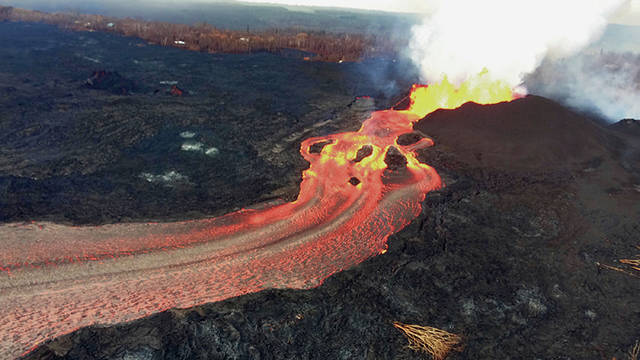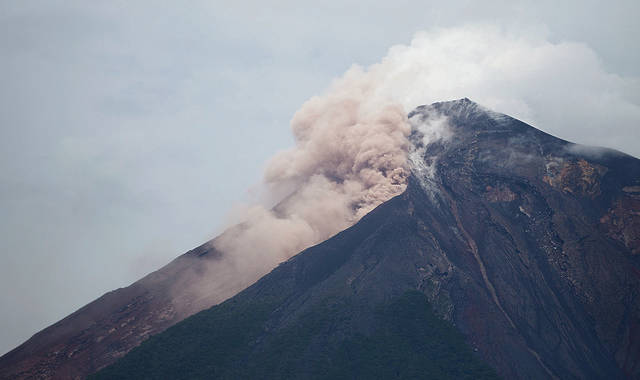Kilauea eruption is classic example of ‘gentle’ volcano

USGS
Fissure 8 below Kilauea Volcano, above, continued to erupt vigorously Sunday on the Big Island.

ASSOCIATED PRESS / JUNE 8
Volcan de Fuego blew out a thick cloud of ash last week in San Juan Alotenango, Guatemala.


Even with as much publicity as the current Puna eruption has garnered, there is still some misunderstanding about Kilauea Volcano’s eruptive behavior.
Fundamentally, there are two kinds of volcanoes, explosive and gentle, with a spectrum of intensities in both groups.
>> Kilauea eruption is classic example of ‘gentle’ volcano
>> Relief center opens today for lava disaster aid
>> Ashfall, vog lowers air quality for residents of Ocean View
>> Big Isle tourism campaign gets love in Ohio
>> Kilauea isn’t Hawaii’s only active volcano
RELATED PHOTOS AND VIDEOS
>> Live webcams from Hawaii island
>> Pahoa business owners talk about drop in business, June 14
>> Heavy vog invades Ocean View, June 14
>> USGS: Kilauea Volcano fissure 8 flow from vent to sea, June 14
>> Influx of new people at Hawaii island Red Cross shelter has brought more crime, June 13
>> Animals on Hawaii island find refuge from lava at local farm, June 13
COMPLETE KILAUEA COVERAGE
>> Star-Advertiser volcano coverage
>> Kilauea Volcano YouTube playlist
Hawaii volcanoes characterize the gentle type, known as shield volcanoes.
Shield volcanoes occur far from the crushing compressive edges of tectonic plates. They are common in Hawaii and other Pacific Ocean island chains, and in Iceland, the Canary Islands and the East African rift, to name the most prevalent.
Don't miss out on what's happening!
Stay in touch with breaking news, as it happens, conveniently in your email inbox. It's FREE!
Explosive volcanoes are associated with convergent tectonic plate boundaries around the rim of the Pacific Ocean, in the Italian/Aegean region and in the Caribbean. These stratovolcanoes are more violent because their magma has a much higher silica and gas content. More silica makes the magma more viscous and therefore more difficult for the greater gas content to escape. They run the gamut in violence from gentle to highly explosive, although even the gentlest are more violently explosive than even the most explosive Hawaii type.
Eruptions of stratovolcanoes such as Volcan de Fuego in Guatemala usually begin with an explosive phase that releases large amounts of gas (mostly water vapor) that comes undissolved in the magma as it rises from a higher pressure deep inside the volcano to a lower pressure near the surface.
The eruption spews pulverized lava as fine ash particles high into the atmosphere along with glowing hot ash flows that race down the volcano’s slopes at 100 miles per hour, engulfing everything in their path indiscriminately and burying it in hot ash that solidifies as it cools into hard tuff.
Thick, relatively cool and viscous lava often follows, covering the ash, which over time builds a steep-sided symmetrical conical composite volcano consisting of alternating layers of ash/tuff and lava. Mount Fuji in Japan is the poster child for this type of volcanic edifice.
The low silica and higher temperatures of shield volcanoes produce eruptions of hot, fluid lava that oozes or fountains out of linear fissures along rift zones that radiate outward from a central vent. Some eruptions occur from the central vent, which often sits inside a caldera a mile or more in diameter.
Unlike violent stratovolcanoes, shield eruptions do not most often occur at the summit. When they do, the lava typically fills the summit crater and overflows. On rare occasions a single explosion occurs when groundwater contacts the magma underground and flashes to steam.
Hawaii eruptions typically begin as gentle fountaining along rift fissures, often forming a “curtain of fire” as fountains have reached 1,000 feet or more in height. Lava from the fountains collects in flows that follow the downhill path of least resistance. The curtain of fire might consist of small eruptive centers along the rift.
Typically, the eruptions along the rift become confined to a single vent, which could continue to erupt and cover the surrounding surface with lava.
The current eruption of Kilauea has followed this pattern as if scripted, with most of the activity now confined to fissure 8.
The actual eruption details are much more complex than summarized here, and a single eruption phase can provide enough data for years of analysis by volcanologists.
MORE KILAUEA COVERAGE
>> Survivors of past Hawaii lava recall despair and opportunity
>> Trump approves individual assistance for Big Island residents affected by lava
>> Health Department seeks public’s input on additional air monitoring stations
>> Another moderate quake, explosion shake Kilauea summit
>> ‘Jurassic World’ crew reacts to Kilauea, Fuego volcanic disasters
>> Hundreds of animals among lava refugees
>> Keep lava viewing safe, organized
>> Ige seeks assistance from federal programs
>> Influx of new people has brought more crime, shelter residents say
>> Vog and toxic air may head toward Hilo
>> Volcanologist talks about Kilauea fissure
>> Helicopter mission allows widow to gather belongings before losing home to lava
>> Opening viewing points might shore up Big Island’s visitor industry
>> Kilauea eruption will fuel volcano research for years to come
>> Photos, words fall short in describing volcano
>> Prolonged papaya shortage expected in wake of volcanic activity
>> A coffee shop in Pahoa has turned into a place of respite for evacuees
>> Micro-housing units under construction in Pahoa for lava evacuees
>> Leilani Estates residents remain behind despite hardships
>> Scientists reap mountain of data from rumbling Kilauea volcano
>> Residents feel safe despite lava but chafe at government controls
>> Hawaii County Mayor Harry Kim loses home to lava
>> Kilauea dashes Oahu newlyweds’ dreams
>> Website to centralize Big Island air quality reporting
>> Kilauea eruption harms up to half of Malama Ki forest reserve
>> Volcanoes National Park’s most important facility damaged by quake
>> Fire helicopter rescues woman, her pet rabbit and chicken isolated by lava
Richard Brill is a professor of science at Honolulu Com- munity College. His column runs on the first and third Fridays of the month. Email questions and comments to brill@hawaii.edu.




